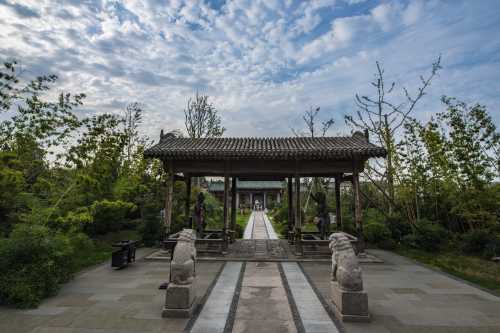Popular Trip Moments
"Han City's Potala Palace" - Puzhao Temple. | 📝Compared to going to Xi'an during the Dragon Boat Festival, I prefer Northern Shaanxi recommended by National Geographic🌄 | Captivated at First Sight in the City God Temple! This Ming Dynasty Stage Will Leave You Speechless | Hancheng two days and one night travel guide | Come! Many monuments, few tourists | 3-Day Tour of the Terracotta Warriors and Horses and Hukou Waterfall in Xi'an - A Must-See Guide! | Hancheng Travel Guide: One-Day Tour | At Hancheng Atour Image Hotel, you can experience the warmth of time! | Feel the charm of ancient buildings in Hancheng | Shaanxi Travel | World-Class Ming and Qing Dynasty Dwellings in Dangjia Village, Hancheng | Hancheng Xiangshan Red Leaves | Stunning Mountain Scenery | Hancheng Dayu Temple | Exquisite mural stories | Hancheng Ancient City | Visit historical sites | Liangdai Village Ruins of Rui State in Hancheng | See Precious Cultural Heritage | Hancheng Beiying Temple | Collection of exquisite decorations such as relief paintings | Dongying Temple in Hancheng | Guandi Temple in the Ming Dynasty | Hancheng City God Temple | Explore Ancient Architecture and History | Jiulang Temple, Hancheng | Records the Story of "The Orphan of Zhao" | Jiujiu Zhai Pagoda, Hancheng | Provincial-level Protected "Golden Pagoda" | Yuxiu Bridge, Weinan | A century-old stone arch bridge over the Jushui River | Why is the Han Cheng Confucian Temple one of the top three Confucian temples in China? | Hancheng Ancient City | Majestic City Walls | Travel Back in Time: Han City Ancient Town Exploration Tour | Temple recommendations. | Is it not worth a visit if it's not the third largest Confucian Temple in China? | Puzhao Temple. | Dangjia Village. | "【Explore the Mysterious Shaanxi】— The Legendary Story of Dangjia Village". | Weinan Confucius Temple, Shaanxi | The largest Confucius temple in western China. | Explore the beauty of traditional villages and experience an authentic historical journey. | Half-day Tour in Hancheng
Recommended Attractions at Popular Destinations
Attraction near Bangkok | Attraction near Manila | Attraction near Tokyo | Attraction near Taipei | Attraction near Hong Kong | Attraction near Seoul | Attraction near Kuala Lumpur | Attraction near Los Angeles | Attraction near Shanghai | Attraction near New York | Attraction near Shenzhen | Attraction near Osaka | Attraction near Singapore | Attraction near London | Attraction near Guangzhou | Attraction near San Francisco | Attraction near Beijing | Attraction near Macau | Attraction near Bali | Attraction near Jakarta | Attraction near Paris | Attraction near Ho Chi Minh City | Attraction near Istanbul | Attraction near Phuket | Attraction near Chicago | Attraction near Seattle | Attraction near Toronto | Attraction near Orlando | Attraction near Cebu | Attraction near Chiang Mai
Popular Attractions
Catacombs of Paris | West Gate Scenic Spot | Asakusa | Safari World Bangkok | Manila Ocean Park | Panoramic Flower Gardens Shikisai-no-oka | Maokong Gondola | Hongshan Park | Universal Studios Singapore | The Sanctuary of Truth | Qingdao Underwater World | Chimelong Paradise | Jiufen Old Street | Badaguan | Xinghai Park | S’Sense Massage Suan Plu | Crane Temple | AIRE Ancient Baths Barcelona | Dalianwan Fort | St Thomas Orthodox Syrian Cathedral | Mount Airy Casino Resort | Synagoge Friedberger Anlage | Crocodile Sanctuary of San Mariano | R K Puram Sec 12 Park | Library | Ekhamra Discgolfbana | Stump Lake View Point | Mandawa | Muzeum Ernsta Wiecherta | City Sightseeing Tour Bus
Popular Restaurants in Hancheng
炭之家大片烤肉(韩城店) | 老常家韩城味道(韩塬路店) | 韩城古城美食街 | Xin'anhongbei (hancheng) | 芝秀羊肉饸饹(韩城店) | Jiushiguang Coffee Shop | 格林麦香健康烘焙坊(桢州公园店) | 韩城南湖假日酒店·餐饮部 | 锦华府餐饮 | 韩城强大格兰云天大酒店·爱丽舍西餐厅 | 同庆祥(紫峰街店) | Dicos (hancheng) | 姚家猪蹄坊 | Chuanbayucun | 花雕醉鸡(韩城店) | YU XIU YANG ROU HE GUAN | XIANG LONG JIAO ZI | 锡佳傲冰煮羊火锅店(韩城店) | 黄河明珠开元名都大酒店国风堂&四季轩中餐厅 | Weijialiangpi | 小海鲜餐厅 | ZHANG XUE YANG ROU HE | 曼尼咖啡(桢州店) | 蜀栈重庆火锅(韩城店) | 肯德基(黄河店) | LA SHANG HUANG HUO GUO | 熊妹涮肉 | 大清花饺子(韩城店) | 唐韵饭店-餐厅 | Jixianglou
Popular Ranked Lists
Popular Best Things to Do in Zhijiang | Popular Premium Hotels Near Samosdelka | Popular Best Things to Do in Leye | Popular Premium Hotels in Bujumbura Mairie | Popular Must-Visit Restaurants in George Town | Popular Must-Visit Restaurants in Osaka | Popular Must-Visit Restaurants in Bangkok | Popular Must-Visit Restaurants in Rome | Popular Premium Hotels Near Novosibirsk | Popular Premium Hotels in Jekan Raya | Top 4 Best Things to Do in Mohe | Popular Premium Hotels in Altai Republic | Popular Luxury Hotels in Brasilito | Top 5 Best Things to Do in Altay Prefecture | Popular Premium Hotels in Central Kalimantan | Popular Best Things to Do in Heyuan | Popular Premium Hotels in Karagandy | Popular Must-Visit Restaurants in Nha Trang | Top 6 Best Things to Do in Fenghuang | Popular Must-Visit Restaurants in Dalat | Popular Premium Hotels Near Kamyzyaksky District | Popular Must-Visit Restaurants in Singapore | Top 5 Best Things to Do in Jiangmen | Popular Premium Hotels in Pipa | Popular Luxury Hotels in Mayen-Koblenz | Popular Must-Visit Restaurants in Koh Samui | Top 4 Best Things to Do in Pingyao | Top 5 Best Things to Do in Suqian | Popular Premium Hotels in Osh | Popular Premium Hotels in Shan
Payment Methods
Our Partners
Copyright © 2025 Trip.com Travel Singapore Pte. Ltd. All rights reserved
Site Operator: Trip.com Travel Singapore Pte. Ltd.
Site Operator: Trip.com Travel Singapore Pte. Ltd.


















